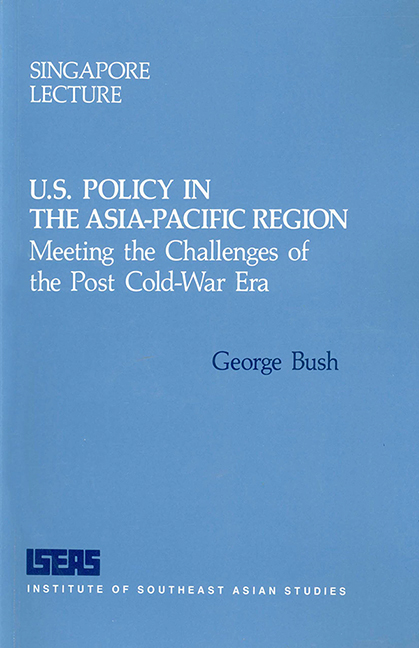II - U.S. Policy in the Asia-Pacific Region: Meeting the Challenges of the Post Cold-War Era
Published online by Cambridge University Press: 09 November 2017
Summary
Thank you, Mr Minister. Prime Minister Goh and Senior Minister Lee, I am delighted to be here and thank you for that very kind introduction. Let me take this opportunity to say a few words about these two gentlemen.
Minister Lee, a quarter century ago, you led this small island of cultural and ethnic diversity, of limited physical resources, to independence. Then, through your vision and your force of intellect and will, you forged Singapore's nationhood. You stood courageously in a life and death struggle against the communists, and you prevailed. You led your nation and your region in the quest for peace and prosperity. It is my convinced opinion that future generations will honour the name of Lee Kuan Yew. And as you know well from your visits to my home in Kennebunkport, I am pleased to know you as a friend.
Prime Minister Goh, I salute you for your wisdom and your vigour in carrying Singapore forward on its path to the future. I pledge America's steadfast friendship as you lead Singapore in facing the challenges of the coming generation. I am also pleased that you, like many of your countrymen, came to the United States of America for part of your education. These, too, are ties that bind us together.
It is an honour to deliver this Lecture, following such leaders as Brian Mulroney, Helmut Schmidt, Rudd Lubbers, Bob Hawke, Mahathir bin Mohamad, and Valery Giscard D'Estaing and such distinguished thinkers as Henry Kissinger and Milton Friedman. And, let me acknowledge: Professor K.S. Sandhu, Director of the Institute of Southeast Asian Studies; A.V. Liventals, Chairman, Mobil Oil Singapore; Lee Hee Seng, Deputy Chairman, ISEAS Board of Trustees; and Dr Richard Hu, Chairman, Monetary Authority of Singapore, and Finance Minister.
The addresses in this series reflect the changes in our world. Your first lecturers focused on the ideological and military struggle between socialism and democratic capitalism and especially between the United States and what we used to call the Soviet Union.
Think of that phrase for just a moment — “what we used to call the Soviet Union”. When citizens pulled down the hammer and sickle ten days ago and hauled up a new tricolour of freedom over the Kremlin, the Soviet Union ceased to exist, and the prospect of a new world opened before us.
- Type
- Chapter
- Information
- U.S. Policy in the Asia-Pacific RegionMeeting the Challenges of Post Cold-War Era, pp. 3 - 12Publisher: ISEAS–Yusof Ishak InstitutePrint publication year: 1992

